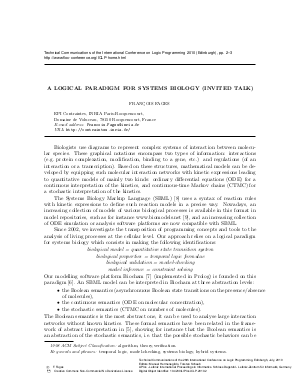A Logical Paradigm for Systems Biology (Invited Talk)
Author François Fages
-
Part of:
Volume:
Technical Communications of the 26th International Conference on Logic Programming (ICLP 2010)
Part of: Series: Leibniz International Proceedings in Informatics (LIPIcs)
Part of: Conference: International Conference on Logic Programming (ICLP) - License:
 Creative Commons Attribution-NonCommercial-NoDerivs 3.0 Unported license
Creative Commons Attribution-NonCommercial-NoDerivs 3.0 Unported license
- Publication Date: 2010-06-25
File

PDF
LIPIcs.ICLP.2010.2.pdf
- Filesize: 379 kB
- 2 pages
Document Identifiers
Subject Classification
Keywords
- temporal logic
- model-checking
- systems biology
- hybrid systems
Metrics
- Access Statistics
-
Total Accesses (updated on a weekly basis)
0PDF Downloads0Metadata Views
Abstract
Biologists use diagrams to represent complex systems of interaction between molecular species. These graphical notations encompass two types of information: interactions (e.g. protein complexation, modification, binding to a gene, etc.) and regulations (of an interaction or a transcription). Based on these structures, mathematical models can be developed by equipping such molecular interaction networks with kinetic expressions leading to quantitative models of mainly two kinds: ordinary differential equations for a continuous interpretation of the kinetics and continuous-time Markov chains for a stochastic interpretation of the kinetics. Since 2002, we investigate the transposition of programming concepts and tools to the analysis of living processes at the cellular level.
Cite As Get BibTex
François Fages. A Logical Paradigm for Systems Biology (Invited Talk). In Technical Communications of the 26th International Conference on Logic Programming. Leibniz International Proceedings in Informatics (LIPIcs), Volume 7, pp. 2-3, Schloss Dagstuhl – Leibniz-Zentrum für Informatik (2010)
https://doi.org/10.4230/LIPIcs.ICLP.2010.2
BibTex
@InProceedings{fages:LIPIcs.ICLP.2010.2,
author = {Fages, Fran\c{c}ois},
title = {{A Logical Paradigm for Systems Biology}},
booktitle = {Technical Communications of the 26th International Conference on Logic Programming},
pages = {2--3},
series = {Leibniz International Proceedings in Informatics (LIPIcs)},
ISBN = {978-3-939897-17-0},
ISSN = {1868-8969},
year = {2010},
volume = {7},
editor = {Hermenegildo, Manuel and Schaub, Torsten},
publisher = {Schloss Dagstuhl -- Leibniz-Zentrum f{\"u}r Informatik},
address = {Dagstuhl, Germany},
URL = {https://drops.dagstuhl.de/entities/document/10.4230/LIPIcs.ICLP.2010.2},
URN = {urn:nbn:de:0030-drops-25776},
doi = {10.4230/LIPIcs.ICLP.2010.2},
annote = {Keywords: temporal logic, model-checking, systems biology, hybrid systems}
}
